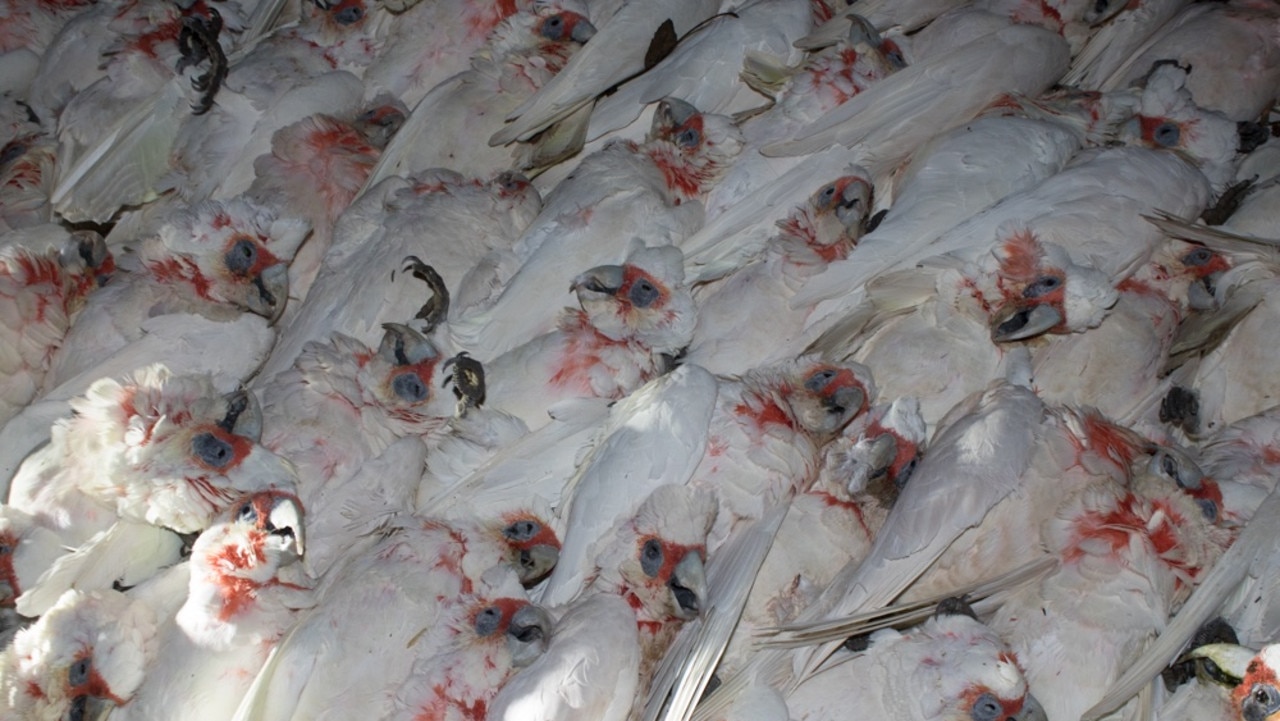More than 100 dead corellas found after suspected poisoning
A wildlife worker has shared the moment she realised something was “seriously wrong” after responding to a report of dead birds in a Victorian town.

Warning: Distressing images
A wildlife rescue worker has issued a desperate plea online after discovering more than 100 dead Corellas, revealing the moment she knew something was “seriously wrong”.
Kirsty Ramadan of Bohollow Wildlife Shelter in Victoria took to Facebook to share the alarming discovery in a bid to raise awareness about the devastating reality of mass culling events.
Ms Ramadan was recently called out to the town of Barmah to capture a “very unwell” Long-billed Corella.
There were also reports of at least five dead birds nearby, one of which a woman saw fall directly out of a tree in front of her.
“I headed out, not knowing what to expect but when I arrived in Barmah it was clear that something was seriously wrong,” she wrote on Facebook.
“The original call was from the Yorta Yorta Centre and I retrieved around ten dead Corellas from the grounds, including two which had died on roofs.
“I quickly realised that the number of birds involved was huge as I began to see dead birds scattered everywhere around the surrounding streets and bushland.”
Stream your news live & on demand with Flash. From CNN International, Al Jazeera, Sky News, BBC World, CNBC & more. New to Flash? Try 1 month free. Offer ends 31 October, 2022 >

Ms Ramadan then began the tedious task of searching through the streets and surrounding bushland, collecting dead birds and finding the occasional live, but clearly unwell, Corella.
After just a few hours, the wildlife worker had collected 105 dead Corellas, though she warned there were many more still dead or dying that she was unable to retrieve.
Out of the 10 birds she picked up that were still alive, all of them died within a few hours of being found.
An autopsy of one of the birds at a nearby vet found clear signs of poisoning, including severe haemorrhaging in the intestine and a gizzard full of stained material.
“These birds are dropping dead out of trees, in mid air and falling into the Murray River and puddles due to excessive thirst which is again, a symptom of poisoning,” Ms Ramadan said.
“There are many more birds out there dead which I have not been able to retrieve yet and also ones suffering.”
She asked anyone in the Barmah, Nathalia or Numurkah areas to please contact Bohollow Wildlife Shelter if they come across anymore birds and to send through any photos of birds found dead on mass.

Speaking to news.com.au on Tuesday, Ms Ramadan said they are still waiting on the results of the official toxicology reports to confirm the cause of the mass deaths.
“It is looking like it is poison of some sort, but whether it was intentional or unintentional we don’t know. It could very well be that someone was deliberately targeting the birds,” she said.
Ms Ramadan said these type of horrific events highlight the impact that using toxins in our environment can have on the wildlife.
“It always has a backlash to our ecosystem. It just so happens that this species is large enough to be noticeable,” she said.
“When it is insects and bugs it isn’t as noticeable but it is still happening all the time.”
Under the Wildlife Act 1975, it is an offence to kill wildlife by poison. A person found guilty of this offence can face penalties of up to $18,174 and/or six months in jail.
Unfortunately, even if the testing is able to determine which substance was used to kill these animals, Ms Ramadan said the likelihood of the culprits being identified and prosecuted “is almost zero”.

Victoria’s Conservation Regulator confirmed it is “investigating the deaths of more than 100 little corellas” at Barmah last Wednesday.
“We are working to determine if the deaths were caused by a disease or as a result of human actions,” the regulator said.
Anyone with information about this case is urged to contact Crime Stoppers on 1800 333 000.
In her online post, Ms Ramadan urged anyone with information about the deaths to come forward, saying if there are consequences for those responsible then it could deter others from doing the same in the future.
“It is time for people to stand up, speak out against crimes against our wildlife,” she said.
“Until more people do and put their fears of pressure from a rural community which seems to condone and accept the horrific treatment of wildlife behind them, this will continue to happen.
“When wildlife is an inconvenience or seen as a liability for whatever reason, it seems to be accepted that we are able to kill creatures through culling measures.”
Ms Ramadan said this applies to both legal channels or culling that is illegally carried out like this in this case.
“Native wildlife face hardship on every level from human activities, there is no animal on earth who is a greater inconvenience, liability and threat to wildlife than Homo sapiens,” she said.




